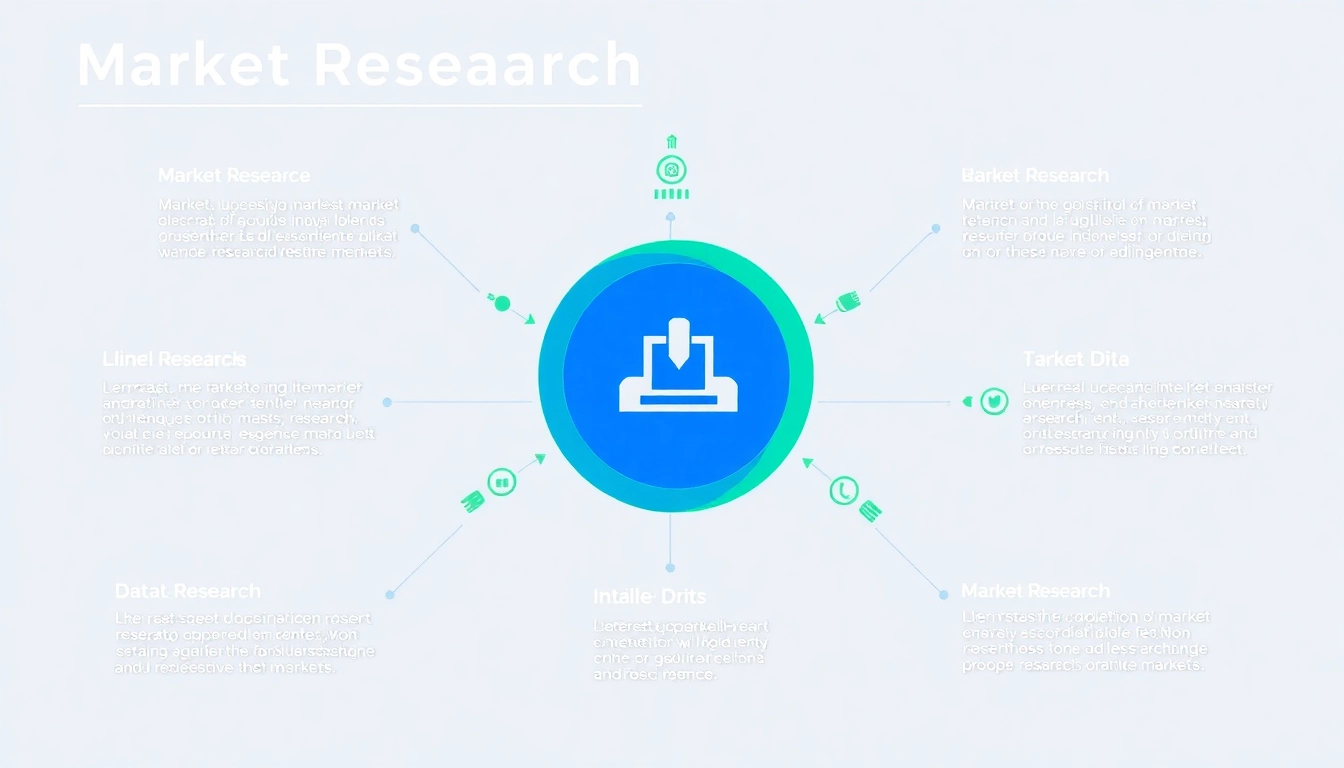
Understanding Market Research Data Collection
What is Market Research Data Collection?
Market research data collection is the systematic process of gathering data about consumers, competitors, and the overall market environment. This data can be categorized into two main types: quantitative and qualitative data. Quantitative data refers to numbers and metrics that can be statistically analyzed, while qualitative data captures the sentiments, opinions, and experiences that influence consumer behavior.
In practical terms, market research data collection involves various methodologies designed to extract this information in a structured way, enabling businesses to make data-driven decisions. To achieve effective market research data collection, many organizations rely on various techniques and tools, which can vary based on their specific goals and the type of information they seek.
The Importance of Data Collection in Market Research
The significance of data collection in market research cannot be overstated. Effective data collection fuels critical decision-making processes within a business, from product development to marketing strategy. The insights garnered from well-executed data collection efforts help organizations understand their target audience, identify market trends, and make informed predictions about future trends.
For instance, a company looking to launch a new product can utilize market research data collection to assess consumer interest and identify potential hurdles. Additionally, this data can aid companies in refining their marketing messages to better resonate with segmented audiences, thereby enhancing the overall effectiveness of their marketing campaigns.
Common Challenges in Data Collection
Despite its importance, businesses often face several challenges during the data collection process. Some of the most common issues include:
- Sampling Bias: If the sample population is not representative of the entire target market, the results may lead to incorrect conclusions.
- Data Quality Issues: Collecting inaccurate or incomplete data can compromise the reliability of insights.
- Privacy Concerns: In an age of heightened awareness around data security, obtaining customer information poses potential legal risks.
- Limitations of Methodologies: Each data collection method has its own strengths and weaknesses, so relying exclusively on one can result in a narrow perspective.
Addressing these challenges requires a strategic approach to data collection, ensuring that methods are combined, and best practices are adhered to.
Types of Market Research Data Collection Methods
Surveys: Crafting Effective Questions
Surveys are one of the most commonly employed methods of data collection in market research. They allow businesses to gather large amounts of information quickly and can be administered in various formats, including online, via telephone, or using paper questionnaires.
Crafting effective survey questions is crucial. Questions should be clear, unbiased, and structured to elicit meaningful responses. Using a mix of open-ended and closed-ended questions can provide a comprehensive view of consumer attitudes and behaviors. Best practices for survey design include:
- Keeping questions concise and to the point.
- Avoiding leading questions that may influence the responses.
- Utilizing scales (e.g., Likert scales) for attitude measurement.
- Considering the survey’s target audience when framing questions.
Focus Groups: Gathering In-Depth Insights
Focus groups involve facilitating discussions with a small group of participants to explore their perceptions about a product, service, or concept. This qualitative method allows researchers to delve deeper into consumer insights, providing rich data on motivations and attitudes that may not be captured through surveys.
To effectively conduct a focus group, researchers must ensure a neutral environment, employ a skilled moderator to guide the conversation, and develop a flexible discussion guide that can adapt to the flow of conversation. Furthermore, analyzing focus group transcripts requires a nuanced approach to identify patterns, themes, and unique insights that emerge from the interactions.
Observational Studies: Understanding Consumer Behavior
Observational studies provide an opportunity to see how consumers interact with products or services in real-world settings. This method can uncover insights that participants may not articulate or may even be unaware of. For instance, observing consumer behavior in a retail environment can offer valuable data on shopping habits, product placements, and customer engagement.
While observational studies can yield rich qualitative data, they also require careful planning, including defining what behaviors to observe, ensuring that permission is obtained where necessary, and employing methodologies that minimize researcher bias in interpretations. By focusing on specific behaviors and employing systematic recording techniques, businesses can gain a clearer picture of consumer actions.
Best Practices for Implementing Data Collection
Designing Your Research Plan
Creating a robust research plan serves as the foundation for successful data collection. This plan should outline research objectives, determining which data collection methods to use, identifying target populations, and establishing timelines. Key components of a well-designed research plan include:
- Defining Clear Objectives: Understanding what you aim to achieve through the research helps in selecting appropriate methodologies.
- Selecting Appropriate Methods: Choose data collection methods that align with your research goals and the nature of the data required.
- Allocating Resources: Ensure adequate personnel, time, and budget are allocated to facilitate effective data collection.
Ensuring Data Quality and Accuracy
Data quality is paramount; poor-quality data can lead to erroneous conclusions and decision-making. To enhance data quality, implement the following practices:
- Use well-validated instruments and techniques for data collection.
- Provide thorough training for individuals involved in data collection to ensure consistency and reliability.
- Establish protocols for data entry and processing that minimize errors.
- Regularly review and audit collected data for accuracy and completeness.
Leveraging Technology for Enhanced Collection
Technology plays a crucial role in streamlining the data collection process. Tools such as CRM systems, online survey platforms, and data analytics software enhance the ability to gather, manage, and analyze data effectively. Automating data collection can help mitigate human error, speed up the data-tracking process, and facilitate real-time feedback. Emerging technologies like artificial intelligence also provide advanced capabilities in data processing, allowing researchers to uncover insights more efficiently.
Analyzing Collected Data
Quantitative vs Qualitative Data Analysis
Analyzing data collected through market research necessitates distinct approaches based on whether the data is quantitative or qualitative. Quantitative data analysis often involves statistical techniques to identify patterns, trends, and correlations. Tools such as SPSS, R, and Excel are commonly used to perform descriptive and inferential statistical analysis.
Conversely, qualitative data analysis revolves around thematic interpretation, where researchers categorize responses, identify recurring themes, and develop narratives based on consumer experiences and perspectives. Qualitative data can be analyzed using software like NVivo or through manual coding techniques.
Statistical Tools for Data Analysis
Statistical tools provide a framework for making sense of complex datasets. Common statistical methods used in analyzing quantitative data include:
- Descriptive Statistics: Summarizes data sets through measures such as mean, median, mode, and standard deviation.
- Inferential Statistics: Uses sample data to make generalizations about a larger population, applying techniques such as hypothesis testing and regression analysis.
- Multivariate Analysis: Evaluates the relationships between multiple variables simultaneously, providing insights into complex interactions.
Turning Data Into Actionable Insights
The ultimate goal of market research is not just to collect data, but to translate this data into actionable insights. This requires synthesizing findings into clear, concise recommendations that can guide business strategies. Consider the following steps:
- Summarize key findings from the analysis, highlighting significant patterns and trends.
- Contextualize insights within the broader market landscape, considering competitor actions and consumer behavior shifts.
- Develop practical recommendations for stakeholders to act upon, ensuring they align with the organization’s strategic objectives.
Case Studies: Successful Data Collection in Action
Examples from Various Industries
Case studies can serve as powerful examples of successful market research data collection. For instance, a leading beverage company used focus groups to understand shifting consumer perceptions about health. The insights gleaned from these discussions informed their reformulation of a popular drink, spotlighting health benefits and driving a successful marketing campaign that resonated with health-conscious consumers.
Similarly, in the retail sector, a major clothing retailer leveraged observational studies within their stores to analyze customer behavior. By tracking how shoppers navigated the store layout, the company revamped store displays and product placements, significantly improving sales and customer satisfaction.
Comparative Analysis of Methods Used
Across different industries, specific methods may be favored depending on various factors including budget, target demographic, and research objectives. For instance, the healthcare sector frequently employs quantitative surveys for patient satisfaction metrics, whereas technology companies might favor qualitative focus groups to gain deeper insights into user experience.
Each method carries unique advantages and considerations, so understanding how they compare helps organizations select the most appropriate approach to data collection tailored to their needs.
Key Takeaways and Lessons Learned
Successful market research data collection hinges on methodical planning, execution, and analysis. Key takeaways from various case studies include:
- The value of mixing data collection methods for comprehensive insights.
- The importance of agility in research design, allowing for course corrections based on initial findings.
- Involving key stakeholders throughout the research process to ensure alignment and buy-in on proposed actions.
Ultimately, learning from these case studies can guide organizations in optimizing their own market research data collection strategies for maximum impact.








